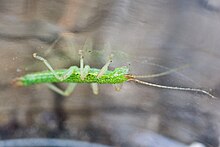Timema
21, and see text Timema is a genus of relatively short-bodied, stout and wingless stick insects native to the far western United States, and the sole extant member of the family Timematidae.
[6] Timema walking sticks are night-feeders who spend daytime resting on the leaves or bark of the plants they feed on.
Timema colors (primarily green, gray, or brown) and patterns (which may be stripes, scales, or dots) match their typical background, a form of crypsis.
[7][8] In 2008, researchers studying the presence or absence of a dorsal stripe suggested that it has independently evolved several times in Timema species and is an adaptation for crypsis on needle-like leaves.
Four (T. ritense, T. podura, T. genevievae, and T. coffmani) rest during the day on the host plant's trunk rather than its leaves and have bodies that are brown, gray, or tan.
[9][10] Timema eggs are soft, ellipsoidal, and about two mm long, with a lid-like structure at one end (the operculum) through which the nymph will emerge.
According to Tanja Schwander, "Timema are indeed the oldest insects for which there is good evidence that they have been asexual for long periods of time.
[5][17] Genetic analysis, published in 2023, of four asexual Timema species suggested that males, which are rare but not entirely absent, do in fact engage in sexual reproduction with some females.
[18] The geographic range of Timema is limited to mountainous regions of western North America between 30° and 42° N.[16] They are found primarily in California, as well as in a few other neighboring states (Oregon, Nevada, Arizona) and in northern Mexico.
[16] Host plants of the different Timema species include Pseudotsuga menziesii (Douglas fir), Sequoia sempervirens (Californian redwood), Arctostaphylos spp.

